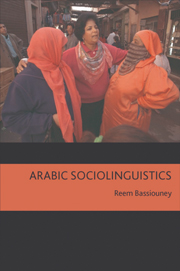Book contents
- Frontmatter
- Contents
- Acknowledgements
- List of charts, maps and tables
- List of abbreviations
- Conventions used in this book
- Introduction
- 1 Diglossia and dialect groups in the Arab world
- 2 Code-switching
- 3 Language variation and change
- 4 Arabic and gender
- 5 Language policy and politics
- General conclusion
- Bibliography
- Index
Introduction
Published online by Cambridge University Press: 05 August 2013
- Frontmatter
- Contents
- Acknowledgements
- List of charts, maps and tables
- List of abbreviations
- Conventions used in this book
- Introduction
- 1 Diglossia and dialect groups in the Arab world
- 2 Code-switching
- 3 Language variation and change
- 4 Arabic and gender
- 5 Language policy and politics
- General conclusion
- Bibliography
- Index
Summary
The earth speaks Arabic.
Egyptian catchphraseThis Egyptian catchphrase has always intrigued me. Of course it shows the amount of pride Egyptians and perhaps all Arabs take in their language. But what I find fascinating is the word ‘Arabic’. What does ‘Arabic’ here refer to? Is it the Standard Arabic used in newspapers? The Classical Arabic of the Qur'an? The colloquial Arabic of Egypt? Or is it the Gulf Arabic of Saudi Arabia? For the layperson, there is only one language called ‘Arabic’. For the linguist, there are at least three different varieties of Arabic in each Arab country, and some linguists even claim that there are at least five different levels of Arabic in each country, not counting the different dialects of each country.
This is the first problem that one encounters in analysing this catchphrase. The other problem that one encounters is why, if ‘Arabic’ is the inherent language of the earth, are Arabs so keen on teaching their children foreign languages. Why is it that in North Africa French is still a crucial instrumental language? And why is it that at the time that all Arabs are defending their language as the main source of pride and identity they are also mastering English and French? The answers to all these questions are not clear cut.
- Type
- Chapter
- Information
- Arabic Sociolinguistics , pp. 1 - 8Publisher: Edinburgh University PressPrint publication year: 2009



